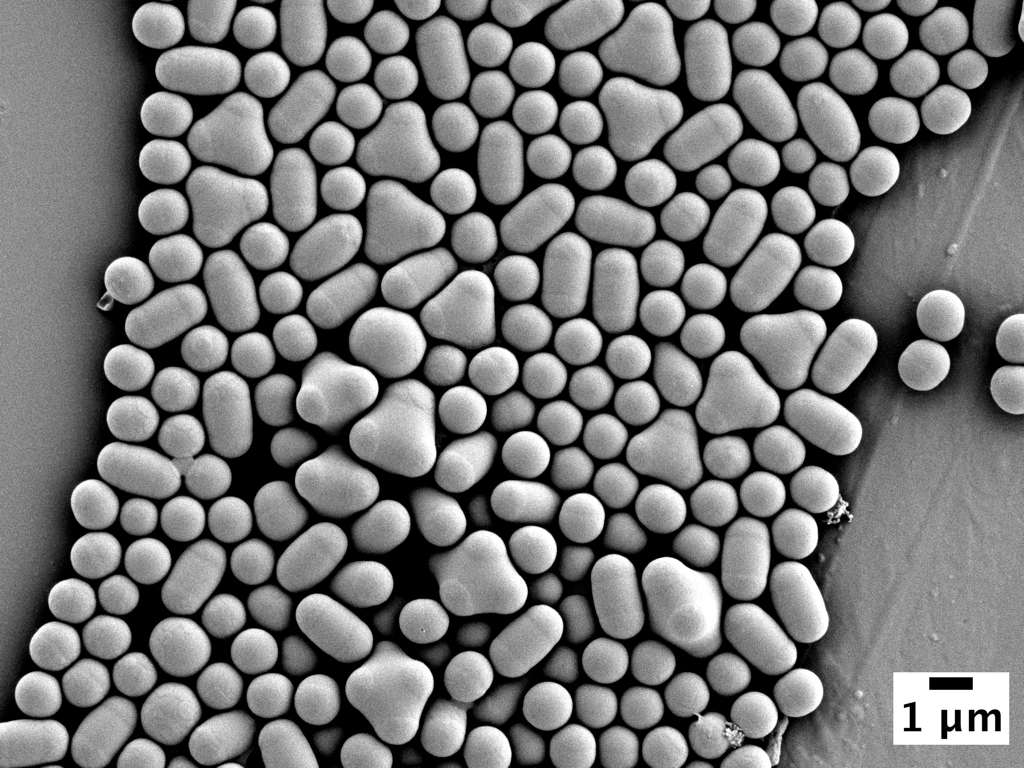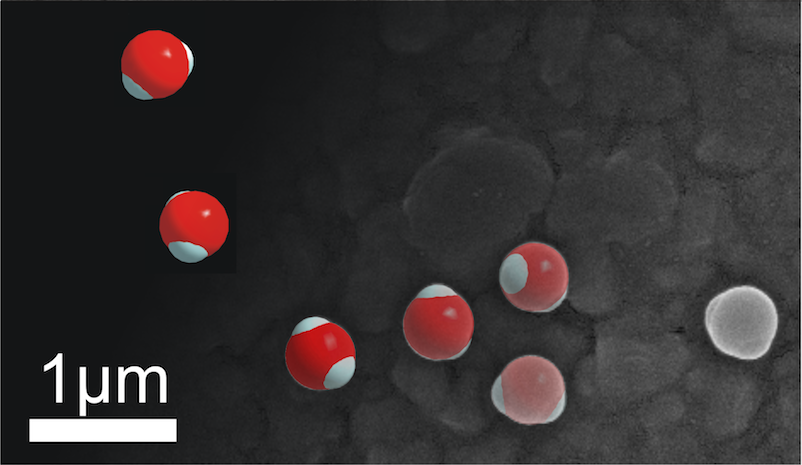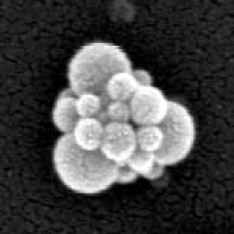Designing colloidal particles
In the Kraft Lab, we regularly develop colloidal particles with new shapes and functionalities and quantify novel types of interactions. These particles can be employed as models for studying active and passive thermal systems.
Superselective colloid-surface binding by multivalent interactions
Reliably distinguishing between cells based on minute differences in receptor density is crucial for cell–cell or virus–cell recognition, the initiation of signal transduction, and selective targeting in directed drug delivery and can only be achieved by multivalent interactions. We developed a versatile, controlled experimental model system that allows quantitative measurements on the ligand–receptor level based on colloidal particles equipped with surface-mobile DNA linkers. These particles superselectively bind to a surface functionalized with the complementary mobile DNA-linkers. ecruitment of the ligand–receptor pairs in the contact area. We found a nonlinear transition in colloid-surface binding probability with increasing ligand or receptor concentration. In addition, we observed an increased sensitivity with weaker ligand–receptor interactions, and we confirmed that the timescale of binding reversibility of individual linkers has a strong influence on superselectivity.
Publications
- C. Linne, D. Visco, S. Angioletti-Uberti, L. Laan, D.J. Kraft, Direct visualization of superselective colloid-surface binding mediated by multivalent interactions, Proceedings of the National Academy of Sciences, 118 (36), e2106036118 (2021)
- C. Linne, E. Heemskerk, J. Zwanikken, D.J. Kraft, L. Laan, Optimality and cooperativity in superselective surface binding by multivalent DNA nanostars, Soft Matter, , (2024)
Colloidal spheres with specific binding affinity
Colloidal particles with specific binding affinity are essential for in vivo and in vitro biosensing, targeted drug delivery, and micrometer-scale self-assembly. Key to these techniques are surface functionalizations that provide highaffinities to specific target molecules. For stabilization in physiological environments, current particle coating methods rely on adsorbed surfactants. However, spontaneous desorption of these surfactants typically has an undesirable influence on lipid membranes. In this work, we developed a surfactant-free coating method that combines high binding affinity with stability at physiological conditions.
Publication
- C. van der Wel, N. Bossert, Q.J. Mank, M.G.T. Winter, D. Heinrich, D.J. Kraft, Surfactant-free colloidal particles with specific binding affinity, Langmuir, 33 (38), 9803-9810 (2017)
Colloidal organosilica spheres

we systematically studied a method to synthesize monodisperse, micrometer-sized spheres from 3-(trimethoxysilyl)propyl methacrylate (TPM) in a benchtop experiment. Their ease of preparation, smoothness, and physical properties provide distinct advantages over other widely employed materials such as silica, polystyrene, and poly(methyl methacrylate)
Publication
- C. van der Wel, G. van de Stolpe, R. Verweij, D.J. Kraft, Micrometer-sized TPM emulsion droplets with surface-mobile binding groups, Journal of Physics: Condensed Matter, 30 (9), (2018)
Colloidal Recycling: Reconfiguration of Random Aggregates into Patchy Particles

While colloidal aggregates are often undesirable due to their random shapes, we exploit them as a starting point to synthesize patchy particles. We achieve a reconfiguration of the aggregates into uniform structures by swelling the polymer spheres with an apolar solvent. The swelling lowers the attractive van der Waals forces, lubricates the contact area between the spheres, and drives the reorganization through minimization of the interfacial energy of the swollen polymer network. This 'colloidal recycling' approach yields patchy particles and clusters with well-controlled size distribution.
Publications
- V. Meester, R.W. Verweij, C. van der Wel, D.J. Kraft, Colloidal Recycling: Reconfiguration of Random Aggregates into Patchy Particles, ACS Nano, 10 (4), 4322-4329 (2016)
- V. Meester, D.J. Kraft, Complex patchy colloids shaped from deformable seed particles through capillary interactions, Soft Matter, 14, 1162-1170 (2018)
Colloidal Particles with Tunable Surface Morphology

Surface morphology is a tool to tune physical properties of colloidal suspensions such as the wettability, viscoelasticity, and depletion attractions. We developed a synthetic approach based on swelling cross-linked latex spheres that can achieve spherical, dimpled and crumpled hybrid colloids with tunable surface roughness. These particles can furthermore be coated with silica, resulting in charge-stabilized hybrid particles and shells with controlled surface morphologies.
Publication
- V. Meester, D.J. Kraft, Spherical, Dimpled, and Crumpled Hybrid Colloids with Tunable Surface Morphology, Langmuir, 32 (41), 10668-10677 (2016)
Self-Assembly of Colloidal Molecules with Liquid Protrusions

We exploit the coalescence of liquid protrusions on cross-linked latex particles to assemble colloidal molecules. Surface energy minimization leads to controlled shapes which can be further controlled by tuning the wetting angle and protrusion size. This enables the fabrication of colloidal molecules with tunable patchiness. (Kraft et al. JACS 2009)

With this technique, we can also synthesize colloids with a well-controlled a bond angle, such as 'colloidal water' and 'colloidal ammonia'. This is achieved by increasing the degree of swelling to the point where the seed particles can freely move inside the fused liquid protrusions. Polymerization induces clustering, which leads to well controlled bond angles that can be 'made-to-order' by adjusting the swelling ratio (Kraft et al. Soft Matter 2009).

By tuning the synthesis conditions, we can control the number of protrusions appearing on the surface of highly cross-linked polymer spheres. High particle yields above 90% are achievable. We employed the technique for polyNIPAM, polystyrene, and magnetite filled polyNIPAM spheres. Partial roughness is achieved through adsorption of secondary particles, or wrinkling of the seed particle surface. (Kraft et al., JPCB (2011))
Publications
- D.J. Kraft, J. Groenewold, W.K. Kegel, Colloidal Molecules with Well-Controlled Bond Angles, Soft Matter, 5(2), 3823-3826 (2009)
- D.J. Kraft, W.S. Vlug, C.M. van Kats, A. van Blaaderen, A. Imhof, W.K.Kegel, Self-Assembly of Colloids with Liquid Protrusions, Journal of the American Chemical Society, 131(3), 1182-1186 (2009)
- D.J. Kraft, J. Hilhorst, M.A.P. Heinen, M.J. Hoogenraad, B. Luigjes, W.K. Kegel, Patchy polymer colloids with tunable anisotropy dimensions, The Journal of Physical Chemistry B, 115 (22), 7175-7181 (2010)